It is only right and fitting that this week’s reading in the Church of MO is 21 years old, since that’s how old you should be to read this lurid comparison: Filled with sexual innuendo, smoldering burnouts and Sunset Strip cruising with an actual rock star and a female tester, this was MO at its most prurient and irresponsible. Thank God we’ve seen the light.
Open Twin Cruisers ’98
The Definition of Cruising
cruise \’kruz\ vb cruised; cruising 1: to be on one’s way 2: to travel for the sake of traveling 3: to go about the streets at random but on the lookout for possible developments 4: to search (as in public places) for a sexual partner.LOS ANGELES, May, 1998 — Cruising is not about speed, high performance, and extreme handling. Cruising is about, well, cruising. Wind-in-your-hair, bugs-in-your-teeth, elemental motorcycling, the way God intended it. On a sportbike, the object is to arrive at your destination as fast as possible. On a cruiser, you are the destination. No hurry. No problem.
Sure, cruiser riders are concerned about performance and power. Witness the aftermarket, which offers pistons and cranks and fuel-injection systems by the truckload. Still, cruisers are, by and large, not purchased as go-fast motorcycles.
Cruising is a lot about styling. Let the crowd on the crotch rockets sneer, but parked at the local hangout, which bikes get the majority of attention from the chicks? True, some women do prefer sportbikes, but a sportbike is more likely to be checked out by another sportbike rider, and almost as often as not, derided rather than admired. Go to the local sportbike hangout and watch them as they circle each other’s bike. On the surface, both pretend to profess admiration, but inside you know both are thinking, with smug satisfaction: “My bike will kick your bike’s ass.” Doubt us?
The cruiser is admired often for what it expresses — a piece of rolling sculpture, a personalized statement on two wheels. And it is because cruisers beg to be customized that objective testing can be difficult. You will not find many of these bikes on the road in stock condition, except for the R1200C, which can be customized but with less options than the others. Also, people ride and expect different things out of cruisers — some prefer torque and muscle, others look for comfort, and a few don’t care as long is it draws attention when it’s parked. It seems that the bike chooses the rider rather than the the other way around. That’s what we discovered as we set out to define cruising.
1: to be on one’s way
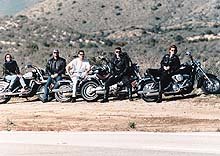
Any worthwhile day trip begins with a good breakfast. In Santa Monica, outside The Omelette Parlor, we lined up the bikes in typical cruiser fashion, at 45-degree angles against the curb, to take in their looks.
One of our testers’ tastes went no further than, “Black is a good color for a cruiser.”
Others dug the art deco, 1930’s streamlined look of the Honda or the unique, post-modern-yet-retro lines of the BMW. As happened in every category, we couldn’t agree.
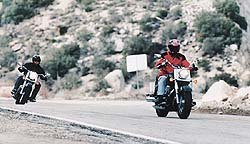
Even the horsepower-hungry proponents of the Suzuki Intruder 1500LC weren’t thrilled by its looks. This bike isn’t simply fat, it’s cartoonishly obese. In pictures, it looks big. In person, it looks huge. Sit on it and it feels even bigger.
If there were more footpegs you could fit two people on each of the seats, and still have room for another pillion passenger. Unfortunately, while American Suzuki designed the tasteful Intruder 1400, Suzuki Japan designed the 1500LC.
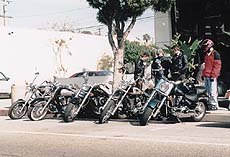
The result is a peculiar combination of size and confusion. It’s big, because someone at Suzuki Japan concluded that in America, size matters. There’s confusion because Suzuki Japan doesn’t seem sure what should be covered and what should be exposed.
The 1500 LC isn’t fully faired, but we get the impression that Suzuki didn’t consider putting a full fairing on this bike. In addition, they forgot or ignored some of the small details that make a cruiser great. The Intruder’s plastic cam covers and faux-chrome engine casings look cheesy.
A giant plate for a floorboard mount, numerous chrome cover-ups and black-painted deceptions only fool the least discerning eye. Plastic covers and chromed-over casings aside, we were disappointed that, in our opinion, Suzuki lost a wonderful opportunity to set the 1500LC apart from the rest of the Japanese cruisers. What looks like a fuel tank is actually an airbox, while the actual fuel tank resides under the driver’s seat. However, instead of being creative with the airbox (see Yamaha’s V-Max), Suzuki played it safe, perhaps too safe, and designed the airbox to mimic a fuel tank. While there’s nothing wrong with that, we only wished that Suzuki’s designers showed more creativity and followed the Milwaukee School of Design a little less faithfully.
“The two bikes that generated the most conflicted opinions about their apperance were the R1200C and the Vulcan Classic, but for completely different reasons.”
The Vulcan Classic is very conservatively styled. Basic black was our test model, with wide bars and chrome accents to set off its dark looks. Everything on the V-Classic is presented tastefully, finding a nice balance between flash and subtlety. Kawasaki even went to great lengths to widen the frame and pull the radiator back into obscurity. But being a motorcycle styled with restraint, while we didn’t find it unattractive, we weren’t awestruck. A little too Milwaukee, perhaps. The dual air boxes look exactly like a Harley Big Twin airbox. The fender struts look like a Xerox copy of Softail struts. While it isn’t exactly original, it is a safe, and at least from the Kawasaki’s point of view, wise approach. Kawasaki estimates that the V-1500 Classic will be their best-selling motorcycle in North America.
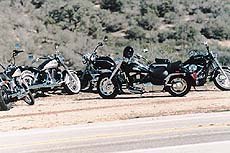
In contrast, the BMW R1200C might be the Kate Moss of motorcycles. Traditionalists find the bike ugly, while the fashion conscious think the bike looks stunning. And it always grabs attention. Park it and watch a crowd develop. On the Sunset Strip, a starlet riding in the passenger seat of her poseur boyfriend’s Mercedes literally crawled over her boyfriend to give a staffer a thumbs up and a wide polished-teeth smile, while “Slick” nodded nervously, rolled up the tinted windows and sped away angrily. For the most part, you can stamp “chick magnet” on the side of the R1200C.
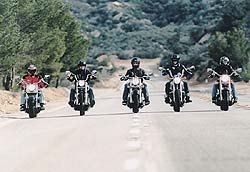
Overall, its unique looks and superb fit-and-finish, coupled with BMW’s usual attention to detail, allowed the R1200C to score high in this category. While BMW’s R1200C Cruiser was a huge hit on the runway with the fashion crowd, the kings of the highway were the Dyna Wide Glide and the Honda Aero.
Like it or not, the fact remains that Harley is the template for this class, and while other manufacturers try not to admit it, styling cues still emanate from Milwaukee. Our bike, a 95th Anniversary Edition model, has classic and restrained lines.
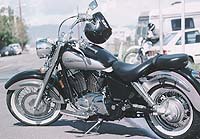
Although Dyna models are perhaps the most difficult Harleys to customize, it still is a Harley, and it dials into an enormously extensive aftermarket, the breadth of which blows away anything else in this shootout.
The sleeper in the styling category was the Honda Shadow Aero. Everyone, from the horsepower junkies to the Harley diehards, admired the Aero’s blend of 30’s art-deco, white-walled tires, streamlined profile and the well-crafted balance it made between tradition and individuality. The Shadow Aero is the least Hog of the Japanese cruisers.
When we reviewed the Honda Shadow ACE in the ’96 Five Fat Bike Shootout, we wrote that “compared to the other machines in the test, the (Shadow ACE) seem(s) like a parts bin special… The headlight is decidedly Japanese curved, and the rider’s eye view is peppered by seemingly randomly-placed instruments and idiot lights… The exhaust pipes really don’t follow such a simple path as it appears: Instead they are routed in and out of the chrome covers. Black paint hides the details… Style is the most important thing to cruiser owners.”
Style may not the most important thing to all cruiser owners, but it is very important to most cruiser owners. With the Shadow Aero, Honda has recognized this fact. The speedometer and idiot lights are located on the Hummell-inspired headlight. A trick two-into-one exhaust pipe looks much better than the convoluted system found on the ACE. Machined fork brackets and footboards, spoke-wire wheels, and chrome is found in in the right proportions in all the right places. Black paint isn’t needed to hide anything. The difference between the Shadow ACE and the Shadow Aero is like the difference between buying a suit off the rack and a suit from a tailor. You wear one because you have to, you wear the other because you want to.
2: to travel for the sake of traveling
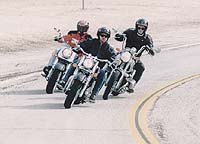
Our test route took us from the beaches of Santa Monica to the snow-covered peaks of Angeles National Forest, then back down to the mean streets of L.A. for a little boulevard bruising. We figured the variation of city streets, open highways and mountain twisties would best simulate the type of riding most owners will do.
Right off the bat, testers began to narrow their lists. Paul Harrell refused to ride the BMW 1200C for more than a couple miles, noting a distinct lack of low-end torque and an aversion to the sideways rotating mass of the crankshaft and driveshaft.
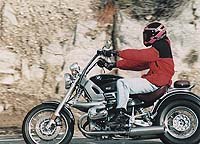
Everyone raved about the postage stamp pillion that folded up into a back rest, except of course, our pillion tester. If you plan to do a lot of two-up riding, plan on ditching the stock seat for the larger, but fixed-position, pillion seat, or else get used to sleeping alone.
The R1200C, weighing only 580 pounds wet and sporting a 64.9-inch wheelbase, was the lightest and most flickable bike in this test. Steering was very precise, although the swept-back ape-hangers did make steering twitchy. The instrument panel is laid out well and all the idiot lights were easy to see and read.
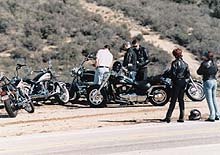
The R1200C has two flaws, serious enough for two testers to rank this bike last. The first is the foot peg position in relation to the protruding, opposed twin cylinders. Unlike BMW’s other Boxers, where the foot pegs are swept back, the pegs on the R1200C are farther forward, placing the riders feet under the cylinder heads. Most testers didn’t notice, but one tester was disconcerted enough to place the bike dead last for this fact alone. Another tester had issues with throttle response. In order to qualify for cruiser duty, BMW increased the bore and stroke, decreased exhaust and intake valves and altered the intake tract to provide for more low-end torque.
Coupled with fuel-injection, the throttle response is abrupt, to say the least. Again, most testers didn’t seem to mind, noting that short-shifting helps smooth out the twitchy throttle responses, but one tester was so annoyed that he ranked the R1200C last.
Both of our female testers disliked the Intruder, but for different reasons. Our pillion tester thought the stock passenger seat was too high, exposing her to too much windblast, and our female rider as well as a few other testers, felt that the big bike was too much to handle.
“Our more squidly testers, AMA Pro Thunder points runner-up Paul Harrell and free-lance motojournalist Kerry Ward, loved the Suzuki’s immense power and torque and forgave any handling deficiencies because of its ability to lighten up the rear wheel and lay big, smokey burnouts.”
The Intruder needs that kind of power because it has to move a 700-pound motorcycle with a 67-inch wheelbase. Because it’s big and heavy it handles like any big and heavy bike, great for straight-line touring but somewhat overwhelming in tight traffic and city streets.
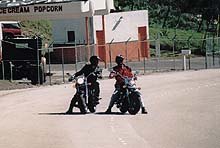 The Vulcan and the Intruder, ready to duke it out.
The Vulcan and the Intruder, ready to duke it out.The consensus was that the Dyna Wide Glide had neutral handling, although one tester complained that it felt vague. Believe it or not, the Wide Glide was the second lightest bike in the test, weighing in at 640 pounds, 20 less than the sleek Aero and 60 pounds less than either the Intruder or Vulcan.
Ground clearance was good, and the only bike with greater ground clearance was the BMW. Steering isn’t heavy, and the mini-apes helped to toss the big Hog around, even though the thin 21-inch front wheel tended to track within the rain grooves on the freeway. Power and torque, even stock form, is more than adequate.
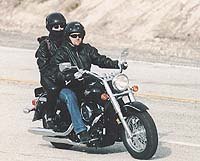
In order for this bike to pass noise and emissions regulations, the exhaust note has been muted, so if you’re looking for that familiar Harley rumble, a new set of pipes may be the tops on your list of aftermarket parts. The Aero’s handling received mixed reviews. Some liked its “almost-drives-itself” handling manners, while others would have preferred more feedback. A universal complaint was the lack of power from the single-pin crank, 1099cc V-twin engine. Apparently, size does matter. With a pillion passenger aboard as we rode through the Angeles National Forest, at an altitude of about 2000 feet, the Aero wheezed and puffed along at under 50 mph while trying to climb a not-very-steep hill.
“Perhaps the most telling testimonial about the rider-friendliness of the V-Classic was that the only female rider, also the smallest person in the test, ranked the Vulcan 1500 Classic first.”
This distinct lack of power raised questions about the suitability of the Aero for two-up touring duty. On the streets and in the mountains, the Vulcan was universally well-liked. Light handling in the tight stuff, while only slightly wobbly at speed, the V-Classic is a very balanced motorcycle. One tester did not like the slight on-off throttle jumps. As with the similarly equipped ZX-9R, we aren’t sure if it’s the K-TRIK throttle position sensor or this particular tester’s style because no other tester logged any complaints. Still, everyone was ecstatic that the Vulcan is finally equipped with a five-speed transmission. Its formerly class-leading horsepower and torque (the Suzuki’s awesome motor does everything a little stronger) responds on demand, and the suspension feels plush but not too soft.
A 120-pound woman feeling secure riding a 700-pound motorcycle: go figure. This supported our observations that the V-Classic probably offered the most balanced package — power, handling, comfort and style — of any bike in this test. The ergonomics were very good, and it shared honors with the Honda and Harley as the winner in overall ergonomics and comfort. Its low seat height, 27 inches, gave Heather the confidence that both feet would touch the ground at a stop, a big concern for smaller riders.
While the clear-cut handling winner was the Vulcan, we argued over long distance comfort. Some liked the scooped, supportive seat of the Harley-Davidson, or the upright, neutral position of the Honda. The Kawasaki and Suzuki fell to the back of the pack in this category, although we did note that the Suzuki was better suited for long distance riding than through congested city streets.
The post Church of MO: Open Twin Cruisers ’98 appeared first on Motorcycle.com.
【Top 10 Malaysia & Singapore Most Beautiful Girls】Have you follow?